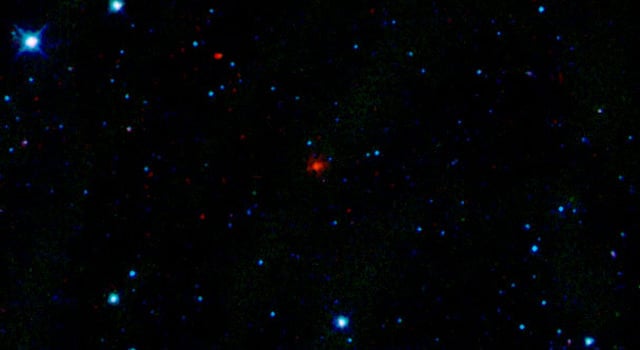[/caption] The Wide-field Infrared Survey Explorer or WISE is living up to expectations, as it now has discovered its first comet, shortly after
finding its first asteroid.
The spacecraft, just launched on Dec. 14, 2009 and first spotted the comet on January 22, 2010. WISE is expected to find millions of other objects during its ongoing survey of the whole sky in infrared light. Officially named "P/2010 B2 (WISE)," the comet is a dusty mass of ice more than 2 kilometers (1.2 miles) in diameter.
[caption id="attachment_55522" align="alignnone" width="273" caption="Animation of WISE Comet discovery W007s0z. Confirmation observation by ARO at magnitude 19.7 with observation from ARO found at MPEC 2010-C23. ARO was the first ground base observation of the WISE comet discovery. Credit: Robert Holmes/ARO"]
[/caption] Comet and asteroid hunter Robert Holmes, who we have
written about previously on Universe Today
(whose Astronomical Research Observatory and Killer Asteroid Project in Illinois is not far from where I live) made the first ground-based confirmation of WISE's comet discovery, with his home-built 0.81-meter telescope. Many large observatories attempted to confirm this discovery more than 7 days earlier including the Faulkes 2.0m telescope in Hawaii, without success. And due to poor weather, Holmes had to wait several days to get a look at the WISE comet himself. Holmes produces images for educational and public outreach programs like the I
nternational Astronomical Search Collaboration (IASC),
which gives students and teachers the opportunity to make observations and discoveries, and a teacher actually assisted in the confirmation of this new comet.
Astronomers from the WISE team say the comet probably formed around the same time as our solar system, about 4.5 billion years ago. Comet WISE started out in the cold, dark reaches of our solar system, but after a long history of getting knocked around by the gravitational forces of Jupiter, it settled into an orbit much closer to the sun. Right now, the comet is heading away from the sun and is about 175 million kilometers (109 million miles) from Earth.
"Comets are ancient reservoirs of water. They are one of the few places besides Earth in the inner solar system where water is known to exist," said Amy Mainzer of NASA's Jet Propulsion Laboratory in Pasadena, Calif. Mainzer is the principal investigator of NEOWISE, a project to find and catalog new asteroids and comets spotted by WISE (the acronym combines WISE with NEO, the shorthand for near-Earth object).
[caption id="attachment_55523" align="alignnone" width="245" caption="Animation of WISE discovery W008anj confirmation observation by ARO at magnitude 21.4. Credit: Robert Holmes/ARO"]
[/caption] "With WISE, we have a powerful tool to find new comets and learn more about the population as a whole," said Mainzer. "Water is necessary for life as we know it, and comets can tell us more about how much there is in our solar system."
"It is very unlikely that a comet will hit Earth," said James Bauer, a scientist at JPL working on the WISE project, "But, in the rare chance that one did, it could be dangerous. The new discoveries from WISE will give us more precise statistics about the probability of such an event, and how powerful an impact it might yield."
Comet WISE takes 4.7 years to circle the sun, with its farthest point being about 4 astronomical units away, and its closest point being 1.6 astronomical units (near the orbit of Mars). An astronomical unit is the distance between Earth and the sun. Heat from the sun causes gas and dust to blow off the comet, resulting in a dusty coma, or shell, and a tail.
Sources:
JPL,
Killer Asteroid Project
 Universe Today
Universe Today
